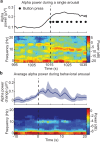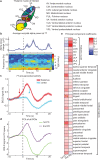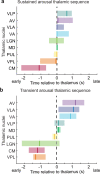A temporal sequence of thalamic activity unfolds at transitions in behavioral arousal state
- PMID: 36114170
- PMCID: PMC9481532
- DOI: 10.1038/s41467-022-33010-8
A temporal sequence of thalamic activity unfolds at transitions in behavioral arousal state
Abstract
Awakening from sleep reflects a profound transformation in neural activity and behavior. The thalamus is a key controller of arousal state, but whether its diverse nuclei exhibit coordinated or distinct activity at transitions in behavioral arousal state is unknown. Using fast fMRI at ultra-high field (7 Tesla), we measured sub-second activity across thalamocortical networks and within nine thalamic nuclei to delineate these dynamics during spontaneous transitions in behavioral arousal state. We discovered a stereotyped sequence of activity across thalamic nuclei and cingulate cortex that preceded behavioral arousal after a period of inactivity, followed by widespread deactivation. These thalamic dynamics were linked to whether participants subsequently fell back into unresponsiveness, with unified thalamic activation reflecting maintenance of behavior. These results provide an outline of the complex interactions across thalamocortical circuits that orchestrate behavioral arousal state transitions, and additionally, demonstrate that fast fMRI can resolve sub-second subcortical dynamics in the human brain.
© 2022. The Author(s).
Conflict of interest statement
The authors declare no competing interests.
Figures







Similar articles
-
Seizures and Sleep in the Thalamus: Focal Limbic Seizures Show Divergent Activity Patterns in Different Thalamic Nuclei.J Neurosci. 2017 Nov 22;37(47):11441-11454. doi: 10.1523/JNEUROSCI.1011-17.2017. Epub 2017 Oct 24. J Neurosci. 2017. PMID: 29066556 Free PMC article.
-
Thalamic arousal network disturbances in temporal lobe epilepsy and improvement after surgery.J Neurol Neurosurg Psychiatry. 2019 Oct;90(10):1109-1116. doi: 10.1136/jnnp-2019-320748. Epub 2019 May 23. J Neurol Neurosurg Psychiatry. 2019. PMID: 31123139 Free PMC article.
-
Synchronized activities of coupled oscillators in the cerebral cortex and thalamus at different levels of vigilance.Cereb Cortex. 1997 Sep;7(6):583-604. doi: 10.1093/cercor/7.6.583. Cereb Cortex. 1997. PMID: 9276182 Review.
-
Generation of human thalamus atlases from 7 T data and application to intrathalamic nuclei segmentation in clinical 3 T T1-weighted images.Magn Reson Imaging. 2020 Jan;65:114-128. doi: 10.1016/j.mri.2019.09.004. Epub 2019 Oct 16. Magn Reson Imaging. 2020. PMID: 31629074
-
Sleep and arousal: thalamocortical mechanisms.Annu Rev Neurosci. 1997;20:185-215. doi: 10.1146/annurev.neuro.20.1.185. Annu Rev Neurosci. 1997. PMID: 9056712 Review.
Cited by
-
Traces of EEG-fMRI coupling reveals neurovascular dynamics on sleep inertia.Sci Rep. 2024 Jan 17;14(1):1537. doi: 10.1038/s41598-024-51694-4. Sci Rep. 2024. PMID: 38233587 Free PMC article.
-
Characteristics of macroscopic sleep structure in patients with mild cognitive impairment: a systematic review.Front Psychiatry. 2023 Jul 20;14:1212514. doi: 10.3389/fpsyt.2023.1212514. eCollection 2023. Front Psychiatry. 2023. PMID: 37547222 Free PMC article.
-
A roadmap towards standardized neuroimaging approaches for human thalamic nuclei.Nat Rev Neurosci. 2024 Dec;25(12):792-808. doi: 10.1038/s41583-024-00867-1. Epub 2024 Oct 17. Nat Rev Neurosci. 2024. PMID: 39420114 Review.
-
High-resolution awake mouse fMRI at 14 Tesla.bioRxiv [Preprint]. 2024 Sep 23:2023.12.08.570803. doi: 10.1101/2023.12.08.570803. bioRxiv. 2024. Update in: Elife. 2025 Jan 09;13:RP95528. doi: 10.7554/eLife.95528. PMID: 38106227 Free PMC article. Updated. Preprint.
-
Shared subcortical arousal systems across sensory modalities during transient modulation of attention.bioRxiv [Preprint]. 2024 Oct 1:2024.09.16.613316. doi: 10.1101/2024.09.16.613316. bioRxiv. 2024. Update in: Neuroimage. 2025 May 15;312:121224. doi: 10.1016/j.neuroimage.2025.121224. PMID: 39345640 Free PMC article. Updated. Preprint.
References
-
- Iber, C. & American Academy of Sleep Medicine. The AASM Manual for the Scoring of Sleep and Associated Events: Rules, Terminology and Technical Specifications (American Academy of Sleep Medicine, 2007).
Publication types
MeSH terms
Grants and funding
LinkOut - more resources
Full Text Sources

